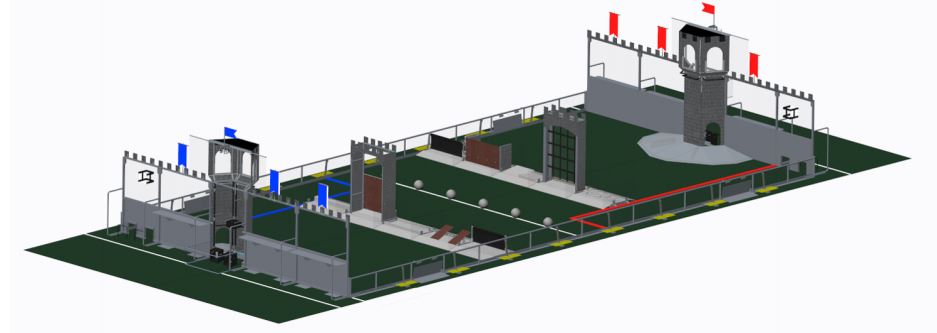Log in if you already have an account. If you would like to become an editor for the wiki, request an account.
Difference between revisions of "2016 FIRST Stronghold"
(→Tower) |
|||
| (3 intermediate revisions by the same user not shown) | |||
| Line 23: | Line 23: | ||
===Outer Works=== | ===Outer Works=== | ||
| − | The outer works is the series of five defensive obstacles that divide the neutral zone from the alliance sections and span the field. Four of the five used obstacles are modular and can be moved, and certain obstacles may or may not be present during a match. Options for defensive obstacles include a Chival de frise, a "moat", ramparts, a drawbridge, a Sally port, a portcullis, a rock wall, and "rough terrain". The defensive obstacle on the left of each outer works, the "low bar", is not movable. LED light strips at the base of each obstacle display current obstacle strength. | + | The outer works is the series of five defensive obstacles that divide the neutral zone from the alliance sections and span the field. Four of the five used obstacles are modular and can be moved, and certain obstacles may or may not be present during a match. Options for defensive obstacles include a Chival de frise, a "moat", ramparts, a drawbridge, a Sally port, a portcullis, a rock wall, and "rough terrain". The defensive obstacle on the left of each outer works, the "low bar", is not movable. LED light strips at the base of each obstacle display current obstacle strength. |
Three defensive obstacles of the outer works in a particular match are determined by the teams playing the match and one obstacle is chosen by the audience. | Three defensive obstacles of the outer works in a particular match are determined by the teams playing the match and one obstacle is chosen by the audience. | ||
| Line 30: | Line 30: | ||
===Tower=== | ===Tower=== | ||
| − | The tower consists of five scoring goals, three scaling rungs, and a "batter". Three high goals are 7 feet 1 inch above the playing field, and two low goals are six inches above the playing field. Three rungs for robots to scale the tower are 6 feet 4 inches from the playing field. Colored LED light strips on the front of the tower display the current tower strength. The "batter" is a series of seven 60° ramps at the base of the tower directly in front of the low goals designed to make challenging and scaling the tower difficult. | + | The tower consists of five scoring goals, three scaling rungs, and a "batter". Three high goals are 7 feet 1 inch above the playing field, and two low goals are six inches above the playing field. Three rungs for robots to scale the tower are 6 feet 4 inches from the playing field. Colored LED light strips on the front of the tower display the current tower strength. The "batter" is a series of seven 60° ramps at the base of the tower directly in front of the low goals designed to make challenging and scaling the tower difficult. |
===Boulders=== | ===Boulders=== | ||
| Line 37: | Line 37: | ||
==Robots== | ==Robots== | ||
These are the robots that our team made for this game: | These are the robots that our team made for this game: | ||
| − | {{#ask:[[robot for year:: | + | {{#ask:[[robot for year::2016]][[robot for competition::FIRST Robotics Competition]] |
|format=ul | |format=ul | ||
|order= | |order= | ||
| Line 43: | Line 43: | ||
|offset=0 | |offset=0 | ||
|limit=20 | |limit=20 | ||
| − | |default=}} | + | |default= no robots have been built yet}} |
| − | |||
==External Links== | ==External Links== | ||
Latest revision as of 00:32, 13 January 2016
FIRST Stronghold was the FRC game in 2016.
Game Description
FIRST Stronghold is the 2016 FIRST Robotics Competition game.The game is played by two alliances of three teams each, and involves breaching the opponents’ defenses, known as outer works, and capturing their tower by first firing "boulders" (small foam balls) at it and then scaling the tower using rungs. Points are scored by crossing elements of the tower's outer works, shooting boulders into the opposing tower's five goals in order to lower the tower strength, and by surrounding and scaling the tower.
Scoring
Autonomous
Robots begin in the neutral zone with one boulder each. However, alliances may assign a "spy" robot to start in the opposing alliance's courtyard. Alliances earn points by moving to the side of the auto zone near the opposing alliance's outer works, and earn more points by crossing them. Once across, a robot in autonomous mode can score a high or low goal.
Robots earn 10 points for scoring a high goal in auto mode, and 5 points for a low goal.
Teleop
Robots retrieve boulders from either the secret passage or the mid line, overcome opponent defenses, and score goals in their opponent's courtyard. Robots may transport only one boulder at a time.
Robots earn 5 points for scoring a high goal in tele-op mode, and 2 points for a low goal.
Field Description
The playing field is divided into red and blue alliance sections, separated by a white neutral zone that contains boulders. Each section contains a courtyard, an area for opposing teams to shoot boulders at the castle goals, a "secret passage" that allows human players to feed boulders to their robots from the human player station, the "outer works", and the tower.
Outer Works
The outer works is the series of five defensive obstacles that divide the neutral zone from the alliance sections and span the field. Four of the five used obstacles are modular and can be moved, and certain obstacles may or may not be present during a match. Options for defensive obstacles include a Chival de frise, a "moat", ramparts, a drawbridge, a Sally port, a portcullis, a rock wall, and "rough terrain". The defensive obstacle on the left of each outer works, the "low bar", is not movable. LED light strips at the base of each obstacle display current obstacle strength.
Three defensive obstacles of the outer works in a particular match are determined by the teams playing the match and one obstacle is chosen by the audience.
There are over 18,000 possible field configurations from the eight defensive options.
Tower
The tower consists of five scoring goals, three scaling rungs, and a "batter". Three high goals are 7 feet 1 inch above the playing field, and two low goals are six inches above the playing field. Three rungs for robots to scale the tower are 6 feet 4 inches from the playing field. Colored LED light strips on the front of the tower display the current tower strength. The "batter" is a series of seven 60° ramps at the base of the tower directly in front of the low goals designed to make challenging and scaling the tower difficult.
Boulders
Scoring elements are called boulders, grey foam balls that are 10 inches in diameter. There are 12 boulders present on the field at the beginning of a match and 18 total. Six boulders are staged evenly along the mid line of the field, and three boulders are at each human player station and in each robot.
Robots
These are the robots that our team made for this game:

